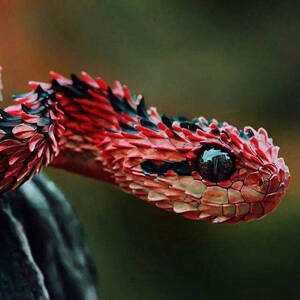Scincella huanrenensis
IUCN
LCBasic Information
Scientific classification
- name:Scincella huanrenensis
- Scientific Name:Scincella huanrenensis,,Huanren dwarfskinkGolden Horse Snake
- Outline:Squamata
- Family:S.family Lizard
Vital signs
- length:10-15cm
- Weight:No verification information
- lifetime:No verification information
Feature
The body is small and slender, and the scales are smooth and without edges.
Distribution and Habitat
Distributed in Laolinggou and Houjiadaozi, Balidianzi Town, Huanren County, Liaoning Province, China (124°50′E, 41°16′N).
Huanren Slippery Lizard inhabits relatively open valley slopes and sparse forest edges, with the highest known habitat at an altitude of 594 meters. It lives under bushes and among dead branches and leaves, and is also seen among rocks on hillsides and occasionally on the roadside.
Appearance
The body is small and slender. The tail is longer than the head and body, about 1.3 times the length of the head and body. The scales are smooth and without edges. The dorsal scales are wider than the side scales, but less than 2 times the side scales. There are 26-28 rows of scales around the middle of the ring body; the dorsal scales have a vertical row of scales from the back of the neck to the front edge of the thigh: 70-80 scales in males, 66-84 scales in females; there are scales on the ventral midline from the chin to the front of the anus: 75-84 scales in males, 77-89 scales in females. The margins of the ventral scales are darker, dark brown. There are 2 pre-anal scales, which are larger and unequal in length and width. There are 4+2 (1/2) rows of scales between the dark longitudinal lines on the sides of the body.
The snout scales are wider than they are high; the nasal scales are larger, and the nostrils are located in the center; there are no upper nasal scales; there is
Details
Huanren dwarfskink is called Huanren dwarfskink in foreign language, and has no subspecies.

Huanren dwarfskink mainly feeds on mosquitoes, flies, spiders, earthworms, insect larvae and moths. Individuals in artificial breeding also eat mealworm larvae, but their preference for them is slightly lower. Huanren lizards start to emerge from hibernation at the end of April, mate in May, give birth in July, and start hibernation in October. Since Huanren lizards have a weak ability to resist enemies, they have many natural enemies, mainly snakes, weasels, some birds of prey, and rodents.
Female Huanren lizards give birth to 2-5 pups, mostly 4, once a year. When giving birth, the egg membrane breaks when passing through the cloaca, and the pups are directly born. When some pups are born, the egg membrane is not broken, and the transparent egg membrane wraps the larvae in it. After a few seconds, the larvae swing and the egg membrane breaks. If the egg membrane is not broken, the larvae will twist their whole body rapidly later and break the egg membrane. The first-born lizards have an umbilical cord on their abdomen, which dries up quickly and is wiped off by the larvae crawling on the ground.
When the first specimen of Huanren lizard was collected in May 1981, the population had dropped significantly, and the people said it was "defeated". This is because the local people used Huanren lizards for medicinal purposes. As the use of folk medicine expanded, the capture of lizards continued to increase. In 1996, the price per lizard increased by 100-150 times compared with 1981. With the increase in the economic value of Huanren lizards and the increase in the difficulty of collection, the population of lizards will continue to decrease.
The main reason for the endangered Huanren lizards is the destruction of their habitat. In the past, Huanren lizards lived in the grass or under the rocks on the slopes, and often hid in them when they encountered natural enemies or were frightened. Later, most of the slopes at the bottom of the mountain were reclaimed into farmland, which greatly destroyed the living environment of Huanren lizards. In addition to environmental factors, hunting by humans is another reason for the sharp decline in its population. It is widely rumored that Huanren lizards have the effect of treating epilepsy and other diseases, so locals and many outsiders come to buy them, resulting in a transaction amount of more than 100 yuan per piece. In this way, local residents catch a large number of Huanren lizards during the slack season, kill them immediately after capture, dry them, and wait for sale.
Listed in the "Red List of Endangered Species of the World Conservation Union" (IUCN 2018 ver 3.1) - Critically Endangered (CR).
Listed in the "List of Terrestrial Wildlife with Important Economic and Scientific Research Value Protected by the State" issued by the State Forestry Administration of China on August 1, 2000.
In 1991, it was listed in the "List of Key Protected Animals in Liaoning Province" of China.
Listed in the second level of the "List of Key Protected Wildlife in China".
Protect wild animals and eliminate game.
Maintaining ecological balance is everyone's responsibility!








